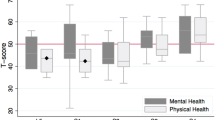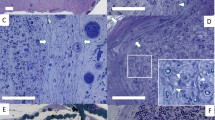Abstract
This study was carried out to discover the prevalence, characteristics and severity of neuropathic pain after wide resection of chordoma of the sacrum by the use of posterior approach. Patients who had chordoma of their sacrums and underwent wide resection via posterior approach, during 1990–2002, were followed up as a prospective cohort. Pain assessment was carried out in terms of onset, characteristics, intensity (numerical rating scale), response to pain medication and associated symptoms. The correlation between patients’ biographic data, preoperative neuropathic pain, type and levels of surgery and pain were analyzed. There were 21 patients; 14 male and 7 female patients. Their ages ranged between 29 and 75 years. Subtotal sacrectomy was carried out in 9 patients and total sacrectomy was carried out in 12 patients. All patients survived the operation. Neuropathic pain was found in 11 patients (52.4 %). Male patients and presentation of preoperative neuropathic pain were significantly related to postoperative neuropathic pain. The other factors were not related to the postoperative pain. Recurrent of severe pain with different characteristics after the operation might indicate tumor recurrent. Early detection of the pain and proper treatment could minimize pain intensity and improved pain management satisfaction.
Similar content being viewed by others
References
Fourney DR, Gokaslan ZL (2003) Current management of sacral chordoma. Neurosurg Focus 15:E9
Zileli M, Hoscoskun C, Brastianos P, Sabah D (2003) Surgical treatment of primary sacral tumors: complications associated with sacrectomy. Neurosurg Focus 15:E9
Kayani B, Hanna SA, Sewell MD, Saifuddin A, Molloy S, Briggs TW (2014) A review of the surgical management of sacral chordoma. Eur J Surg Oncol. doi:10.1016/j.ejso.2014.04.008
Varga PP, Szövérfi Z, Lazary A (2014) Surgical treatment of primary malignant tumors of the sacrum. Neurol Res 36:577–587
Fourney DR, Rhines LD, Hentschel SJ, Skibber JM, Wolinsky JP, Weber KL, Suki D, Gallia GL, Garonzik I, Gokaslan ZL (2005) En bloc resection of primary sacral tumors: classification of surgical approaches and outcome. J Neurosurg Spine 3:111–122
Asavamongkolkul A, Waikakul S (2012) Wide resection of sacral chordoma via a posterior approach. Int Orthop 36:607–612
Guo W, Tang X, Zang J, Ji T (2013) One-stage total en bloc sacrectomy: a novel technique and report of 9 cases. Spine (Phila Pa 1976) 38:E626–E631
Clarke MJ, Dasenbrock H, Bydon A, Sciubba DM, McGirt MJ, Hsieh PC, Yassari R, Gokaslan ZL, Wolinsky JP (2012) Posterior-only approach for en bloc sacrectomy: clinical outcomes in 36 consecutive patients. Neurosurgery 71:357–364
Angelini A, Ruggieri P (2013) A new surgical technique (modified Osaka technique) of sacral resection by posterior-only approach: description and preliminary results. Spine (Phila Pa 1976) 38:E185–E192
Solomon MJ, Tan KK, Bromilow RG, Al-mozany N, Lee PJ (2014) Sacrectomy via the abdominal approach during pelvic exenteration. Dis Colon Rectum 57:272–277
Saigal R, Lu DC, Deng DY, Chou D (2014) Conversion of high sacral to midsacral amputation via S-2 nerve preservation during partial S-2 sacrectomy for chordoma. J Neurosurg Spine 20:421–429
Li D, Guo W, Tang X, Yang R, Tang S, Qu H, Yang Y, Sun X, Du Z (2013) Preservation of the contralateral sacral nerves during hemisacrectomy for sacral malignancies. Eur Spine J (Epub ahead of print)
Jahangiri FR, Al Eissa S, Jahangiri AF, Al-Habib A (2013) Intraoperative neurophysiological monitoring during sacrectomy procedures. Neurodiagn J 53:312–322
Devor M (2013) Neuropathic pain: pathophysiologic response of nerves to injury. In: McMahon SB, Koltzenburg M, Tracey I, Turk D (eds) Wall and Melzack textbook of pain, 6th edn. Elsevier, Philadelphia, pp 861–888
Jensen MP, Chodroff MJ, Dworkin RH (2007) The impact of neuropathic pain on health-related quality of life: review and implications. Neurology 68:1178–1182
O’Connor AB (2009) Neuropathic pain: a review of the quality of life impact, costs, and cost-effectiveness of therapy. Pharmacoeconomics 27:95–112
Hansson PT (2008) Neuropathic pain: definition, diagnosis criteria, clinical phenomenology, and differential diagnosis issues. In: Castro-Lopes J, Raja S, Schmelz M (eds) Pain 2008: an updated review, refresher course syllabus. IASP Press, Seattle, pp 271–276
Sherman RA (2003) Postamputation pain. In: Jensen TS, Wilson PR, Rice ASC (eds) Clinical pain management: chronic pain, 1st edn. Arnold, London, pp 427–436
Chavez NF, Zweizig SL, Stewart EA (2003) Neuropathic uterine pain after hysterectomy. A case report. J Reprod Med 48:466–468
Rothemund Y, Grosser SM, Liebeskind U, Schlag PM, Flor H (2004) Phantom phenomena in mastectomized patients and their relation to chronic and acute pre-mastectomy pain. Pain 107:140–146
Nikolajsen L, Jensen TS (2006) Phantom pain. In: McMahon SB, Koltzenburg M (eds) Wall and Melzack’s textbook of pain, 5th edn. Elsevier, Churchill Livingstone, China, pp 961–972
Marbach JJ, Raphael KG (2000) Phantom tooth pain: a new look at an old dilemma. Pain Med 1:68–77
Hsu C, Sliwa JA (2004) Phantom breast pain as a source of functional loss. Am J Phys Med Rehabil 83(8):659–662
Guo Y, Yadav R (2002) Improving function after total sacrectomy by using a lumbar-sacral corset. Am J Phys Med Rehabil 81:72–76
Conflict of interest
None.
Author information
Authors and Affiliations
Corresponding author
Rights and permissions
About this article
Cite this article
Phimolsarnti, R., Waikakul, S. Prevalence of neuropathic pain after radical sacral chordoma resection: an observational cohort study with 10-year follow-up. Eur J Orthop Surg Traumatol 25 (Suppl 1), 225–231 (2015). https://doi.org/10.1007/s00590-014-1533-x
Received:
Accepted:
Published:
Issue Date:
DOI: https://doi.org/10.1007/s00590-014-1533-x




